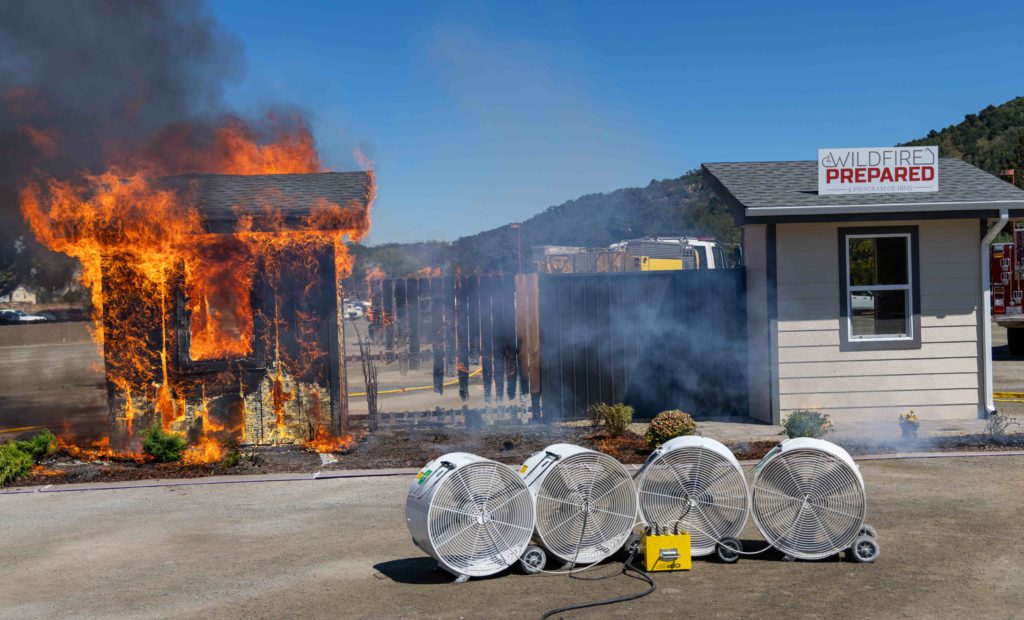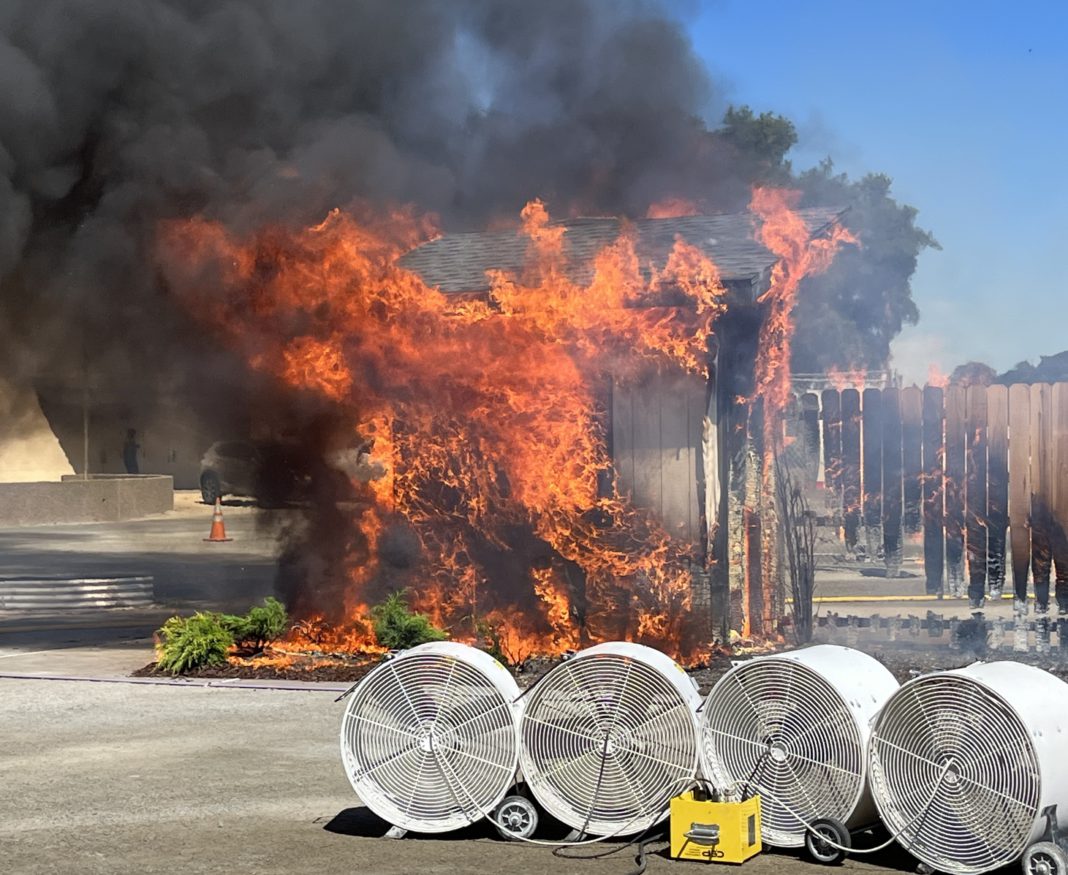In about 20 minutes, a wind-driven fire destroyed one structure while the building next door remained virtually unscathed. It all began with clumps of mulch catching fire in front of each structure.
A few mitigating measures could have left both standing.
The building devastated by fire conformed to typical California building standards, yet had no chance once wind-blown embers ignited a juniper bush next to it. The flames quickly reached the eaves and then engulfed the structure.
Why didn’t the fire spread to the adjacent building? It was built to science-based wildfire-prepared standards. It also had a five-foot buffer zone, free of the plants and wood fencing surrounding the burning structure.
Last weekend, Fire Safe Marin’s Ember Stomp, an event at the Marin County Fairgrounds, dramatically demonstrated a wildfire’s impact on these two structures. Thousands of residents attended to learn about wildfire preparedness, “home hardening” and resilient landscaping.
Most onlookers at the demonstration expressed surprise that the two buildings had such different fates. The structures looked similar and were close together.

“It is amazing what five feet of non-combustibility can do for the risk at each individual home,” Anne Cope, Ph.D., said in an interview.
For the last 15 years, Cope, chief engineer at the Insurance Institute for Business & Home Safety (IBHS), has studied the effects of wildfires and other catastrophic events on buildings. The science gleaned at the IBHS laboratory in South Carolina has been adopted into some material testing standards and building codes.
Although a nonprofit organization, IBHS is supported by the insurance industry—the same companies that substantially raise rates for many California homeowners, cancel longtime customers or cease to write new policies in some areas. Cope said she understands the hardships consumers face.
“Mother Nature is everywhere,” she explained. “The number of billion-dollar disasters every year—the trend is an upward slope. With more damage and inflation, there are so many difficulties right now for American homeowners. Nowhere is that more evident, though, than in the state of California.”
Economists believe California’s homeowners insurance issue has reached a crisis level, driven by wildfire damage. The financial losses are staggering. From 2017-2021, CalFIRE estimated that wildfires were responsible for almost $50 billion in property damage (after adjusting for inflation). Meanwhile, California lawmakers are reviewing regulatory reforms for the insurance industry.
As a research engineer, Cope wants to help homeowners by educating them about damage mitigation. Adapting a home to withstand wildfire risk provides “a great talking point” when contacting insurance agents to shop for a homeowners policy.
While there are no guarantees, it could tip the scales. IBHS has even launched a two-tiered certification program for homeowners who meet strict standards to protect their homes and yards against wildfire.
Of course, shoring up a home doesn’t just help with insurance rates. Wildfires cause personal devastation—and it’s not all financial. There’s a 90% chance a home will be destroyed once it ignites, according to the IBHS.
Cope and her team have developed science-based home-hardening measures by studying wildfires post-event and lab research. The IBHS center uses full-scale homes to measure the effects of wind-driven disasters, including wildfires.
“We can recreate realistic winds in that facility and subject a two-story home to the types of things that will actually occur to it—hurricane-force winds, hailstorms, wind-blown embers,” Cope said. “There are some scientific things that just cannot be scaled down to the dollhouse size, like asphalt shingles, vinyl siding and an ember-resistant vent in the attic.”
Research has established that wind-blown embers from a wildfire create the most substantial risk to homes. Fortunately, a homeowner doesn’t need to tear down and rebuild to reduce their home’s chance of igniting from embers.
“There’s absolutely stuff that homeowners with existing homes can do—today,” Cope said. “The physical aspects of my building, what I can touch, typically comes to mind. But that’s the second thing. The first and most critical wildfire preparedness that every homeowner can start in on right now is defensible space.”
Defensible space requires creating a five-foot buffer zone around a home by removing all combustible materials, including vegetation, trees, artificial turf, wood and vinyl fencing, outdoor furniture and even vehicles. Another component of an ignition-free area involves adding a hardscape, such as pavers, gravel, soil or a sidewalk.
While a barren buffer zone creates a different appearance for homes, Cope maintains that it’s still attractive. She points to the winning designs from a recent wildfire-resilient landscaping contest at UC Berkeley, with budgets ranging from low to high.
For do-it-yourselfers, she recommends moving all the bushes and other vegetation away from the house to a different part of the yard, keeping the greenery visible from the windows.
“You can have a home that has beautiful curb appeal and is wildfire-prepared,” Cope said.
Other mitigation methods involve improvements to the house. The size and cost of projects vary—anything from replacing the roof to simply buying metal mesh from the hardware store to cover vents.
Homeowners should ensure they have the highest-rated roof, Class A, which specifies materials that have survived a severe fire test. Most California homes have Class A roofs, Cope said. Interestingly, the structure destroyed by fire during the Ember Stomp demonstration had a Class A roof that held up well during the blaze.
Preventing wind-blown embers from entering a home through vents in the attic, roof and crawlspace is another important measure. Installing ember-resistant vents reduces this risk. Cost-conscious homeowners can cover existing vents with a non-combustible mesh wire screen, one-eighth of an inch or less.
Next, homeowners should address the base of the house. Cope explained that large embers will roll across the ground and end up next to a home. Installing six inches of vertical non-combustible material at the base of exterior walls and decks will guard against embers igniting those areas. The good news is that many homes already have this feature because typical building codes require it to prevent termites.
IBHS has an extensive checklist to guide homeowners through the necessary steps for a wildfire-prepared home. Some of the actions require retrofitting.
“To go to that higher level of protection, homes need non-combustible siding, dual pane, tempered glass windows and more,” Cope said.
Some of these measures require significant financial investments and will remain out of reach for homeowners on a budget. However, Cope emphasized that even if a home has vulnerabilities, like wood siding, adding five feet of defensible space makes a substantial difference.
“The real challenge to our suburbs is those thankfully rare events where the fire gets out of control,” Cope said. “Sadly, it comes storming towards the neighborhood with the wind-blown embers. If we can guard against those embers and prevent the suburb from catching fire, we can significantly decrease the impacts that wildland fires have on our communities.”











